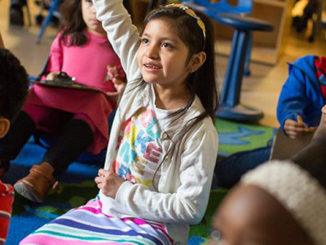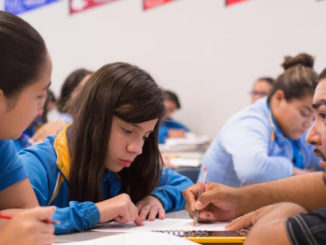
Republican victories in Virginia show how COVID-19 has fundamentally changed American politics.
by Zachary D. Carter
Republican Glenn Youngkin’s victory in Tuesday’s Virginia gubernatorial election was about schools. It wasn’t about Donald Trump, or inflation, or defunding the police, or Medicare for All, or President Joe Biden’s infrastructure agenda. It wasn’t really about critical race theory or transgender rights—though those issues shaded the situation a bit by highlighting anxieties surrounding the education system. Fundamentally, the contest was about schools—specifically, how many parents remain frustrated by the way public schools have handled the coronavirus pandemic.
Whether the Virginia results translate to other states will depend on how schools in those states reacted to the spread of COVID-19, and whether a major national issue can take the place of these local frustrations in voters’ minds. All the usual caveats about drawing too many conclusions from a single contest apply. The national political environment could change, the 2022 midterms are a whole year away, and Virginia isn’t a perfect microcosm of America. But given the very public, ongoing dysfunction among Democratic leaders in Washington, the party’s devastating loss in Virginia looks like a five-alarm fire for its near-term electoral future.
Everyone expected a close race, but the results are worse for Democrats than even the most optimistic Republicans had any right to expect. Not all the votes have been counted, but in an election that shattered turnout records for an off-year gubernatorial race, Youngkin defeated the Democratic candidate, former Governor Terry McAuliffe, in a state that Biden carried by 10 points just a year ago. In 2017, the state’s last gubernatorial election, Democrat Ralph Northam won by nine points.
The unraveling began at the schools. COVID-19 has been terrible for everyone, and it has been especially hard on parents. Unpredictable school closures didn’t just screw up parents’ work schedules; they drove millions of parents, including 3 million women, out of the workforce altogether. Remote learning doesn’t work well for most kids and has been accompanied by rising levels of depression and anxiety among students. From April to October last year, the nationwide share of doctor visits that were related to mental health spiked 24 percent for kids ages 5 to 11, and 31 percent for kids ages 12 to 17. Existing disparities in learning got worse, with the biggest hits coming to kids with disabilities, kids from low-income families, and kids from Black and Latino families—all demographics that Democrats expect to do well with at the ballot box.
Most students in Northern Virginia public schools went almost a full year without in-person schooling, and both teachers and teachers’ unions pretty consistently supported keeping the schools closed in the name of public health. Whether these decisions were ultimately reasonable is hard to measure—but the governor was largely absent on school policy at a time when a lot of parents were really angry.
Polling indicates that they are still really angry. Education was the top issue in the contest, according to the latest Washington Post/SCHAR poll, narrowly edging out the economy, 24 to 23. Democrats typically do very well on education in Virginia—suburban voters organize their lives around well-funded public schools. But this year, Youngkin entered Election Day up nine points over McAuliffe among voters who said education was their top priority.
The most important data point for the election is public-school enrollment in Northern Virginia, and it’s very bad for Democrats. Fairfax County, the largest county in the state, has lost more than 10,000 students since the start of the pandemic—a decline of about 5 percent. In neighboring Arlington County, the dropoff is 3.9 percent; in Loudoun County, it’s 3.4 percent. Those may look like modest declines, but they should not be happening in prosperous counties where the population is growing quickly. The public schools in all three counties have a reputation for quality. People move there for the schools. (Some of the influx into those areas can be chalked up to white flight from D.C. and other suburbs—particularly in Loudoun—but a lot of it can’t. Northern Virginia is a pretty diverse place.)
Most of the coverage ahead of the Virginia elections focused on culture-war issues. Youngkin ran an ad featuring a wealthy suburban mom who wants to ban Toni Morrison’s Beloved in Fairfax County Public Schools. The press published a flood of stories about Republican rage over vaguely defined problems with a vaguely defined critical race theory in history classes, and paid a lot of attention to a sexual-assault case in Loudoun County that conservatives successfully transformed into a battle over transgender bathroom access. (The case was much more complicated than activists claimed.)
Conservative political activists want these issues to prove that “wokeness” is unpopular and that an anti-woke backlash will bring Republican salvation not only in Virginia, but across the country. The truth is a bit more complex. Polling suggests that there is something of an anti-woke backlash taking place, but the right has settled on K–12 schools as the epicenter of its narrative for a reason: A lot of suburban parents lost faith in Virginia’s public schools over the past year, and as a result, they’re more open to conservative narratives about problems in public schools.
I grew up in Northern Virginia and attended Northern Virginia public schools and was back in Northern Virginia from March 2020 until September 2021. Anecdotally, I’ve never heard so much anti-teacher sentiment in the region as I did during the pandemic. Every parent I talked to had at least one horror story, and I mostly talked to affluent, upwardly mobile, pro-public-goods liberals.
Losing the Virginia suburbs is a bigger problem for Democrats than it might appear. Democratic Senator Mark Warner has been winning statewide elections since 2002, but he almost lost his seat in 2014 after running a bad campaign in a Republican wave election. The GOP has held the governor’s mansion for only four of the past 20 years, after Bob McDonnell won the seat in 2009, one year after Barack Obama became the first Democratic presidential candidate to carry the state since 1964. (Keen observers will note that this year’s election also takes place one year after a Democratic presidential victory.)
In 2009, a Republican winning back the governor’s mansion wasn’t particularly frightening for Democrats as a national party. But in the years since, Virginia has become a model for the party’s strategy in other states: maintain big margins with Black voters, win over immigrant families by pointing to GOP xenophobia, and turn suburban homeowners into Democrats with appeals to competence and moderation.
This became a model because it worked, at least in Virginia. In 2002, both Virginia senators were Republicans, along with eight of its 11 House members. Today the governor, both senators, and seven House members are Democrats. The key to those wins was a shift in suburban and exurban voting, a phenomenon familiar to people who follow national political demographics. Republicans have figured out how to swing a bunch of these voters back into their camp. If they can sustain this trend in other suburbs in other states, the Democratic Party’s national viability is in serious trouble.
The good news for Democrats is that education is only narrowly beating out the economy as the top issue for Virginia voters, and that McAuliffe came close, despite running a clueless and lethargic campaign. Democratic leaders in Washington also can’t do that much more damage to local politics than they have this year. By holding up Biden’s economic agenda for more than six months, Senators Kyrsten Sinema of Arizona and Joe Manchin of West Virginia have made it all but impossible for Democrats to highlight achievements on the national stage. Frustrations over COVID-19 school closures may well abate with the passage of time. And Democrats may refocus political attention on issues where they perform better with voters, by simply passing some legislation.
But I wouldn’t put a lot of money on a turnaround. Barring a wild new development over the next year, Democrats should expect to lose Virginia’s Second, Seventh, and Tenth Congressional Districts a year from now, and be ready for a dogfight for the Fourth District. These losses alone would be enough to eliminate the current Democratic majority in the House of Representatives, absent offsetting victories elsewhere.
If you project similar troubles in suburban districts in other swing states, you get a disastrous midterm for the Democrats. COVID-19 has fundamentally changed American politics, and the Democratic Party hasn’t figured out how to navigate those changes.



